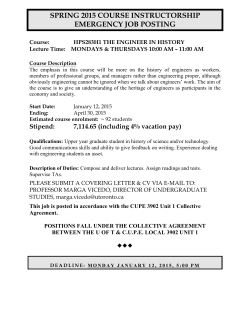
Why to be Wary of “Design for Developing Countries”
THINKING Why to be Wary of “Design for Developing Countries” by Krista Donaldson I ’m not a fan of using the word “developing” to describe people. What makes a society developed? Wealth? Mass consumerism? Stability? Equality? There are several projects that attempt to measure happiness—and few correlate it with gross domestic product or per capita income. And “developing country” seems like a summation of two misnomers considering that the borders of most post-colonial countries are European map carvings with minimal thought to the local people. With my work, I tend to stick with “less industrialized economies.” It’s not a great label and produces a terrible acronym, but it is scalable and gets away from the more subjective issues of development. That said, I still refer to design aimed at promoting social well-being and helping people meet their basic needs as “design for development.” My mother-in-law, like my own mother, cuts out newspaper articles (a lot of them) and sends them to me in the mail. My mother’s articles tend toward raising a non-bratty teenager (we have a toddler), buying a house (still renting!), and sometimes I’m-not- sure-what from the hometown paper. My mother-in-law, on other hand, reads The New York Times religiously and mostly sends me articles on new inventions for poor people in some part of the “developing” world. Sigh. She sends me these articles because I studied and did product development in Kenya, a “developing” country, for many years and still do some work in other such countries. I save these articles even though I invariably cringe reading them. The most recent addition to my pile, “Stove for the Developing World’s Health” from The New York Times, reads like most of the other ones: nice young (usually white, usually male) Westerner visits (or reads about) poor country, is appalled by something he sees/reads, goes home and designs a solution, starts an NGO, and brings his solution to the poor country. The accompanying picture shows a clearly impoverished—but happier—user with product in a dark hut or on a sunburned scrubby dirt road. (Sidenote: for a particularly startling and offensive one, check out the visual for the Surprisingly Spring 2008 Ambidextrous 35 LifeStraw that has an African woman sitting in a pond drinking water from it.) The article often continues with the standard background information on the potential broader impacts of the new product (better family income, better community health, better education for children), followed by a quote from a United Nations bureaucrat, and ends with a hopeful conclusion outlining the details of the product’s largescale rollout plan in several countries. Needfinding, it seems, is limited to testing prototypes developed in the West. Test markets before rollout don’t seem to be a part of the plan. And what happens to these well-intentioned products? Often, not much. After an initial honeymoon period, so few seem to have a lasting positive impact. A year after introduction—is it still being used? Does it still work? If so, is it being used to meet the original need? It isn’t unusual to see the parts and components of a donor’s latest technology cannibalized to make a table, a chair, or added to the siding of one’s abode. There are thoughtful debates on “design and development” versus “design for development” (and “development by design” too). These may seem pedantic, but they highlight many issues related to product design that is aimed at improving the lives of marginalized populations. I see a lot of design for developing countries instead of design in developing countries. I wish I saw more 36 Ambidextrous Surprisingly Spring 2008 design in less industrialized economies. If the goal is to sustainably improve the livelihood of people who do not have their basic needs met, we need to talk about more than the product—even good artifacts like KickStart’s and IDE’s water pumps and the jiko stove, which are truly life changing. We need to talk about the bigger issues—like, what is the goal of “development” and how do we as a global community get there? (If indeed development as we define it in the West is a destination.) Much design for development work tends to be short-term ventures dependent on Western designers’ free time and/or the fiscal schedules of donor agencies. Understandably, the goal in these situations is a product. It makes sense; the design of an artifact seems like a manageable scope. But this shorttermed-ness is all too well-known in most less industrialized economies. In Kenya, an expat colleague who was doing user testing of a cargo bicycle was told, “It’s fine for you if I buy this product and it breaks because you will go back home. Me? I’m stuck here with it.” A longer term perspective involves building not just products but also local capacity, skills, knowledge, experience, and expertisethat enables societies to meet their own needs. Ironically, many economies that are less industrialized and that utilize outside technical assistance have a surplus of unemployed trained engineers and designers. In many cases, these locally-trained engineers lack the useful experience, capital, and political support needed to tackle pressing social and humanitarian problems. Remote design (design from afar) and parachute design (design from afar with visits) do not lend well to capacity building, let alone product sustainability. The challenge of making remote design appropriate and useful is not a new realization despite the persistence of this model. In 1984, Victor Papanek, after some notoriously paternalistic musing on “design for the Third World,” came around to believing that remote design “will most certainly fail.” Gui Bonsiepe, a leading critic of design for development practices, noted in a 2003 interview: “Design problems will only be resolved in the local context, not by outsiders coming in for a stopover visit.” There is a further danger in remote and parachute design—this model tends to promote a technology-centric approach rather than a user-centric one. Technology-centric design, particularly of the subsidized or donated varieties, rarely has a positive impact—and if it does, again, it is often unsustainable. Without immersion with users, without being in-situ, without a sense of culture, language, norms, and deep understanding of the problems faced—an iterative product development process slips from market-pull to technologypush. People aren’t using condoms in Africa to prevent HIV? The aid community’s response was that “social marketing” to modify people’s behaviors (to use condoms) was what was needed. To me, this “solution” wasn’t meeting the needs of the intended population—and no amount of free condoms or clever educational advertising would meet those needs. Design for development customers are like customers in any society— except they are vulnerable. A failed product, particularly one in which users have invested effort, money, and personal pride, can lead to dire consequences such as the loss of money that might be used for a child’s school fees. Foreign designers aren’t the only ones who have difficulty relating to local user needs in these contexts. Kenyan colleagues also had to overcome a significant gap—they were universityeducated and part of the local elite; our customers were not. In my experience, product sustainability is dependent on its meeting needs while still being affordable—and affordable with minimal outside interventions such as subsidies. Economic viability of design for development products is also highly dependent on the user’s return on investment and a functioning supply chain. The most successful design for development products are those that help people earn or save money—not help them be more efficient, save time, or even neces- sarily improve health (particularly if it costs more). What is a necessity to one culture is frivolous to another—and these differences are not just between people of differing income levels. A product that fulfills a niche in Rajasthan may not in Uttar Pradesh. Understanding user needs is not just about individuals but also the economic environment, infrastructure, and society. This later stage work is what makes or breaks a project and determines what its impact will be. In the Irrawaddy region of Myanmar, word spreads from farm to neighboring farm about a great new water pump. In the Kenyan highlands, newly wealthy farmers remain tight-lipped about their pump to discourage requests for loans. I just got back from a design workshop put on at two Chinese universities. One of the exercises was to come up with your own design innovation principle based on your professional experiences. I decided a good one for design for development might be “Broadcast your failures” (with the corollary of “And let everyone learn from them.”) I’ll start with one of my own. Working in Iraq on electricity reconstruction, I was surprised to see that U.S. engineers had given Iraqi counterparts English manuals for newly supplied combustion turbines. With frequently recurring and costly maintenance problems, I thought, “Duh. We need to get these manuals translated into Arabic.” No, an Iraqi colleague told me through a translator—while they might be generally monolingual, the engineers and technicians universally preferred the English manuals because nuanced information is lost in translation. They all learned enough technical English over their years of work to read the manuals. Lesson learned: assume nothing. Ever. Always ask. At least I learned this lesson before wasting more U.S. reconstruction money. While it is unlikely I’ll being seeing any New York Times cutouts on failed products for poor people, I would like to see more and more honest “where are they now” articles like we are starting to see with the One Laptop Per Child (OLPC) $100 laptop. I’m not naïve though—development projects are donor-funded and when raising money you certainly don’t want to highlight your failures. Reporters and others too are loathe to criticize people who are perceived (or perceive themselves) to be doing something noble. Nicholas Negroponte, founder of the OLPC movement, told a Nigerian reporter that he didn’t respond to criticism. Knocking his effort, he said, was like “criticizing the church or the Red Cross.” I’m okay with constructively criticizing either. Shall we start? Surprisingly Spring 2008 Ambidextrous 37
© Copyright 2025


















